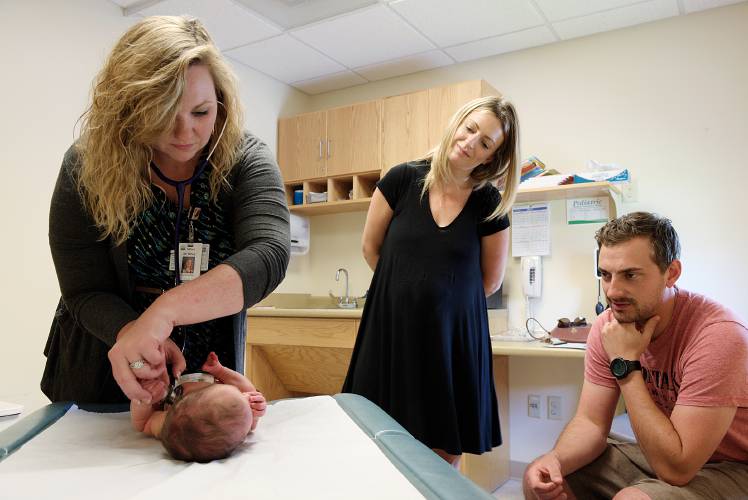LEBANON, NH | Valley News Staff Writer | Sunday, August 06, 2017
Original article can be found at: http://www.vnews.com/
____
Who do you call when you want to know if a cough is just a cough or if it’s a sign of something more serious?
Primary care providers are often the first line of support for patients in search of answers to such questions. These doctors, nurse practitioners and physician assistants act as diagnosticians of a wide variety of conditions and serve as gatekeepers for specialists.
But, recruiting these generalists can be challenging, particularly for rural practices. Though circumstances vary from hospital to hospital in the Twin States, many have trouble attracting and maintaining the primary care workforce they need.
Maps of the Twin States produced in July by the Bi-State Primary Care Association, which recruits physicians, nurse practitioners and physician assistants for practices in Vermont and New Hampshire, list more than 60 vacancies in each state for primary care positions in the areas of family medicine, internal medicine, pediatrics, psychiatry and dentistry. When specialists are added in, the number of vacancies climbs to more than 70 in both states. And, the recent addition of behavioral health and substance abuse counselors in New Hampshire has brought the number of vacancies there to well over 100.
“I think that that number is beyond critical,” said Dr. Louis DiNicola, a long-time pediatrician at Gifford Primary Care in Randolph who is currently serving as Gifford’s medical director for primary care. “Recruitment to rural practice has been difficult.”
Such practitioners often work worse hours and make less money than their counterparts in other areas of medicine, he said.
Vacancies can force hospitals to resort to expensive temporary employees. They can increase stress for current providers and make it difficult to develop relationships with patients — relationships that often are essential to providing continuity in patient care and a source of job satisfaction for providers.
While patients generally can get in to see someone when they need to be seen, it may not always be their provider of choice, Upper Valley hospital officials said.
In both states, positions with the greatest number of vacancies are the roles of associate providers — nurse practitioners, physician assistants and certified nurse midwives — according to the vacancies for which the Bi-State Primary Care Association is recruiting, which includes positions in community health centers, hospitals, private practices, and community mental health centers, but does not include all vacant positions in the two states.
After associate providers, the next highest demand is for family doctors and internists.
As both states struggle to meet mental health and substance abuse treatment needs, practitioners in those fields also are beginning to be regarded as primary care providers. In New Hampshire — where Bi-State recently began recruiting for behavioral health and substance abuse professionals — there is a high need for psychiatrists, psychiatric nurses, counselors and social workers.
The situation is similar in Vermont, where the University of Vermont Office of Primary Care and Area Health Education Centers Program — which also tracks physician vacancies — reports a high need for psychiatrists.
‘A Buyer’s Market’
Since DiNicola entered the profession in the 1970s, the way physicians train has changed, he said. More residents who start out in fields such as pediatrics or internal medicine then go on to a fellowship in a specialty. Specialists tend to work better hours and are more highly compensated, which can be important because the cost to attend medical school has also risen. New physicians now sometimes complete their training owing as much as $300,000 in student loan debt.
The challenges DiNicola and some other Upper Valley recruiters face include requiring providers to be on call at night and on weekends. Larger hospitals often have hospitalists who provide inpatient care during those hours, so when a potential recruit hears that she might have to come in at night to care for a patient, they sometimes hang up the phone, DiNicola said.
“It’s a buyer’s market,” he said.
Gifford isn’t alone.
“I don’t know of a hospital that isn’t recruiting primary care (providers),” Peter Wright, the chief executive of Valley Regional Hospital in Claremont, said recently.
Wright said in mid-July he was seeking a family medicine physician and an internist. He was also planning for the retirement of another family medicine physician in the next few years.
It’s a small pool of people who go into primary care and an even smaller group who want to work in a rural area, Wright said. Even among those who do, Wright said, he competes with Dartmouth-Hitchcock Medical Center and Alice Peck Day Memorial Hospital, both centrally located in the Upper Valley, for employees.
“Give someone those three options and an even smaller percentage want to work in Claremont with us,” he said.
Challenges to recruitment include insufficient training programs in the Twin States to fill all of the vacancies, difficulty finding work for providers’ partners in their chosen professions in rural areas and a higher rate of turnover than in the past, said Stephanie Pagliuca, who directs Bi-State’s recruitment center.
Even if all of the primary care providers who train in the two states stayed, they would not fill all of the positions available here, Pagliuca said.
In family medicine, for example, the University of Vermont has just one residency program and Dartmouth-Hitchcock has one New Hampshire-based affiliated residency program at Concord Hospital. Each program graduates between six and eight physicians per year, according to the American Academy of Family Physicians website.
Competition for providers is fierce because candidates don’t have to look far to find positions, and they’re often in less rural settings.
There are “a lot of openings right at their feet in southern New Hampshire,” Pagliuca said.
‘Generalists at Heart’
A lot of students enter medical school thinking they want to be primary care providers, said Dr. Cathleen Morrow, chairwoman of the Department of Community and Family Medicine at Dartmouth’s Geisel School of Medicine.
But, over time, Morrow said, many students lean toward a specialty. Her job, though, is to “help the people who really are generalists at heart.”
The future physicians are concerned about compensation, their ability to pay back loans, the sense of prestige associated with specialty fields and the need to know how to manage a broad range of conditions, Morrow said.
Primary care physicians may lag behind specialists in compensation, but they are well-paid relative to other professions, she said. And, she tells them, they will be able to repay their loans, “I promise,” she said.
Family and general practitioners in Vermont earn $196,000 on average annually as of May 2016, according to the Bureau of Labor Statistics. In New Hampshire, they earn $237,000 annually on average.
In comparison, an anesthesiologist in Vermont and nationally earns an average of $270,000. Average earnings for New Hampshire anesthesiologists were not available.
Because medicine is demanding work no matter the specialty, Morrow advises students to pick a field that will keep them engaged throughout their careers.
“People have to find a way to sustain themselves over a lifetime,” she said.
Aurora Robledo, a fourth-year medical student at Geisel, plans to make a career in family medicine.
The 29-year-old Robledo, who is currently on a neurology rotation in California, said she likes the variety of conditions she can expect to see as a family practitioner.
“I want to know the babies, the grandpas, the grandmas,” she said, “help the moms through their pregnancies (and) help children find who they are and make smart decisions.”
Part of the reason Robledo, who grew up along the southern border of Texas, has entered medicine is that she hopes to act as a bridge between the medical community and people who, like members of her family, are suspicious of medical providers.
Primary care is “a lot of education and a lot of relationship building,” said Robledo, who hopes to work in a rural, underserved community.
Her decision isn’t driven by anticipated future earnings, she said.
Though Robledo expects to graduate with about $200,000 in student debt, she said, “I will be just fine.”
Dr. Joanna Culver, who recently completed a three-year internal medicine residency at DHMC, also said getting to know her patients is one of the joys of the work.
“As a primary care doctor, in each patient encounter you have an extraordinary chance to talk with someone about almost all aspects of their life,” she wrote in a recent email. “One primary care doc described their visits as ‘sacred spaces,’ and I think that is really true.”
Having that relationship allows the provider to effect change over time, Culver said. This is particularly true for chronic conditions such as mental health issues, and management of conditions such as weight, hypertension, diabetes, heart disease, smoking and alcohol abuse, she said.
Of course, it is a job that also comes with challenges, including “pressure to see more patients in less time, decreased control over scheduling, pressure to do extensive documentation for the purpose of billing rather than patient care, and the sense that meeting benchmarks is sometimes valued above providing what we as providers feel is quality patient care,” she said.
Match Making
Because of past mismatches, Wright now vets recruits more thoroughly to find a good fit between the physician and the region, he said.
He weeds out people who are primarily interested in Valley Regional’s proximity to Montreal or Boston and is drawn to those who say they like to spend their free time outdoors.
The people who land at the Claremont hospital tend to be very mission-driven, with an interest in treating the underserved, he said.
They also tend to have some connection to the region, having grown up here or attended school here, he said.
Sometimes, Wright said, Valley Regional is able to attract physicians who are mid-career and looking to return to the region after some time away.
Valley Regional, like other hospitals, has also turned to a team approach including more nurse practitioners and physician assistants.
One such new provider is Julie Stewart, a nurse practitioner who works at Valley Regional’s primary care practices in both Claremont and Newport.
Now 39, Stewart grew up in Claremont, graduated from Stevens High School and later earned a nursing degree at New Hampshire Technical Institute in Concord.
She joined the primary care team at Valley Regional last November. Prior to joining Valley Regional, Stewart worked as a registered nurse in Springfield, Vt., while earning a nurse practitioner degree through Walden University online.
Stewart enjoys the diversity of the patients she sees, from newborns to geriatric patients in need of end-of-life care, she said.
In September, a family medicine physician is expected to join the practice, which in addition to Stewart currently includes two pediatricians, she said. The new doctor will enable the practice to accept more new patients and give patients another option, Stewart said.
In the meantime, Stewart said, “I feel like the patients that we have, their needs are being met.”
An Emphasis on Community
For DiNicola, who came to Vermont from Pennsylvania, where he studied and trained, to be Gifford’s sole pediatrician, the most effective selling point for recruitment is the sense of community.
“Become part of Vermont, part of the community, that’s the strongest card that I play,” he said.
Dr. Courtney Riley is one of Gifford’s new recruits. Riley, a 29-year-old Manchester, N.H., native, joined Gifford’s pediatric team last year after doing her residency at the UVM Medical Center in Burlington.
During her time in Burlington, she communicated with providers around the state about the needs of the patients in her care.
“It felt like we were all caring for the kids,” she said.
Riley applied to four positions in Vermont and received offers from each of them.
She landed at Gifford because she fell in love with the community in Randolph, she said. Many of the hospital’s staff had been there for 30 or more years, which made it seem like a good place to work, she said.
The town also has easy access to Interstate 89, which makes it convenient for trips to see her family in Manchester or her husband’s family in Massachusetts, she said.
Randolph is also an approximately 20-minute commute to Vermont Law School in South Royalton where her husband, a tax accountant, is now working toward a law degree.
Access to student loan repayment programs at Gifford — operated by Gifford Health Care, which has federally qualified health center status — was a factor in Riley’s decision to work at Gifford. Though she declined to say how much she owes, Riley said she took out loans to finance both her medical degree at New York Medical College and her bachelor’s degree at Clarkson University, she said.
But, Riley said the comparatively low pay didn’t deter her.
“I don’t come from money,” Riley said.
On average, a pediatrician in Vermont makes $144,000 annually, according to the Bureau of Labor Statistics. A pediatrician in New Hampshire makes $209,000, on average.
So far, Riley said, she is enjoying small-town living. She joined a community choir, regularly attends trivia night and signed up for a pottery class.
“I think it’s fun,” she said. “I can’t go anywhere without knowing someone.”
Paying it Forward
Loan repayment programs are the primary financial incentive that the two states have to entice primary care providers to work in underserved areas and with underserved patient populations.
A New Hampshire commission focused on the primary care workforce is aiming to get more money for loan reimbursements for primary care providers.
The state has $250,000 annually to put toward new applicants’ loan repayments, down from $400,000 prior to 2016, said Danielle Weiss, the state’s primary care workforce program manager.
There are 28 people on New Hampshire’s waiting list for loan repayments, said Laurie Harding, a registered nurse and former state representative from Lebanon who now serves as chairwoman of the state primary care workforce commission.
“For us, over and over we’re told by Bi-State Primary Care … the most important thing we could do is offer loan repayments,” Harding said.
Unfortunately, the commission wasn’t able to persuade the Legislature to support the loan repayment program with additional money this year, she said. They had asked for between $400,000 and $600,000 in additional money.
In Vermont, the state’s loan repayment program received 165 applications for 2017 and was able to offer awards to 30 of those applicants, according to Elizabeth Cote, director of the Office of Primary Care and Area Health Education Centers Program at UVM.
This discrepancy illustrates that demand for the program is outstripping the availability of funds, Cote said. The state is spending approximately $442,111 to repay loans for primary care providers in 2017, Cote said.
While the loan repayment program is important for Vermont to compete with other practices around the country, Cote said, “I would never want policymakers to think it is the silver bullet.”
Some primary care medical, dental and mental and behavioral health clinicians in the Twin States also qualify for federal loan repayment funds through the National Health Service Corps, administered by the Health Resources and Services Administration. This money, about $300 million annually, is distributed to those who work in high-need, underserved areas, such as those who work at federally qualified health centers.
But, because the Twin States often don’t appear to have the most severe shortages according to federal metrics, the money isn’t always available to providers here who apply for it.
Burnout and Turnover
Getting providers to join a practice in Vermont or New Hampshire is really just the first hurdle. The next challenge is getting them to stay.
Pressure to see more patients in less time, increasingly complex medical needs associated with the aging population and the opioid epidemic, and the time it takes to complete documentation through electronic medical record systems can all cause burnout.
“The stress of primary care has just really grown exponentially,” said Dr. Mary Joyce, the medical director of Mt. Ascutney Physicians Practice.
In general, Joyce finds that providers are leaving primary care to do things that are more like shift medicine, whether it be urgent care or hospitalist positions, she said.
Among the things pushing people out of primary care is something Joyce called “the stress of ownership.”
“The patients are yours,” she said.
Even when her patients are treated elsewhere, she is responsible for tracking what is happening with them. She gets 10 notes a day from patients, she said. For each note, she has to open up a patient’s chart and update it.
Turnover can be rough on providers and patients. Because developing relationships with patients over years is part of the joy of family medicine, that is lost when providers move on within a few years of starting a job in a new community.
It can also be hard on those they serve.
“It’s torture for the patients,” Joyce said. “They want their doctor and we just don’t have it.”
Part of the reason for the turnover is a change in the way providers approach medicine, said Joyce, who began practicing in 1985. She said those who are new to the profession are more likely to switch jobs within three to five years.
By leaving so soon, younger providers never establish long-term relationships with patients. Joyce, who earlier in her career delivered babies and visited patients in nursing homes, said that by giving up participating in those elements of life, part of the satisfaction of practicing as a family physician has been lost.
“We’ve carved things up,” she said. “It makes it harder to find that joy.”
Mt. Ascutney officials are taking steps to curb burnout.
The profession requires that providers deliver bad news, and small errors can be catastrophic, she said. Days aren’t perfect and the hours are long.
“It’s work fraught with stress,” she said.
Joyce said she’s not sure exactly what the solutions are, but she thinks that talking about burnout is the first step. When providers are feeling stressed, Joyce said, it’s important to make room in their schedules so they can go for a run or do something else that they find relaxing.
Burnout is also a serious concern for Dr. Edward Merrens, co-interim chief executive of Dartmouth-Hitchcock.
“If physicians are burned out, the rest of the team feels it and the patient feels it,” said Merrens, a hospitalist and D-H’s chief clinical officer.
D-H officials are working to give providers tools that may make their jobs easier such as software they need to be able to dictate their notes, rather than typing them, he said.
In addition, D-H is working to give providers more opportunities to spend time together through things like focus groups or shared meals, he said.
This is “one of the major issues in medicine today,” Merrens said. “We’re committed to taking it on head on.”
Success Stories
Some practices in the Upper Valley say they don’t struggle as much as others to recruit and retain primary care providers.
At Alice Peck Day Memorial Hospital, for example, officials say that recruitment by fellow providers helps bring new people on board. In addition, Dr. Dale Vidal, executive director of APD’s Multi-Specialty Clinic, said providers are not required to stick to quotas in the numbers of patients they see each day, which allows them to take the time they need to meet with patients and families. As a result, Vidal said, recruitment is not challenging for APD.
“They drop in our lap here,” Vidal said.
In the last three years, aided by peer recruitment among current APD providers, the Lebanon hospital has hired three new to mid-career physicians, Vidal said. Because many of APD’s leaders are also physicians, APD prioritizes helping providers maintain a work-life balance, she said.
“Providers keeping themselves healthy,” she said. “We really do focus on that.”
Cottage Hospital in Woodsville has also been successful at recruiting providers, said Maria Ryan, the organization’s chief executive.
“We have been pretty lucky at Cottage,” she said. “Physicians want to be a part of us.”
Cottage, which has 35 beds, is an attractive place to work, she said, because providers there focus on things they can do and don’t try to do everything, she said. Cottage has a Level IV trauma center and a unit devoted to the treatment of geriatric behavioral health. It does not offer obstetrics care.
Due to its small size, Ryan said, Cottage offers providers the ability to feel like they’re making a difference without a lot of institutional barriers to change.
“If it’s the right thing to do … you just change it,” said Ryan, who is also a nurse practitioner.
Providers often are drawn to Cottage because they have a tie to the area or because they are seeking a lifestyle change, Ryan said. And loan repayment programs are available to Cottage providers, she said.
Rural medicine isn’t a good fit for everyone, she said. For some providers who have trained at larger hospitals, working as part of a smaller team can be challenging, she said.
Rural providers “have to be good diagnosticians,” she said.
Kasey Cushman, an advanced practice registered nurse at Cottage Hospital’s Rowe Health Center in Woodsville, said she enjoys the challenge of dealing with a wide variety of conditions.
“Primary care might not seem that exciting,” she said. But, “(you) really never know what your day is going to look like.”
After briefly working in an acute care setting in Connecticut this spring, Cushman, who earned a bachelor’s degree from Lyndon State College and grew up in Lyndonville, Vt., searched for a job back home. After searching for a month, she landed on Cottage, where she started in June. It’s a 30-minute drive from her parents’ home in Danville, Vt.
Cushman, who graduated from UVM’s accelerated master’s degree program in January, said she feels supported by her fellow Rowe Health Center providers, which include another nurse practitioner and a physician.
As a new provider, she sees patients in 40-minute appointments and doesn’t feel pressured to fit more in her schedule. And although she does find herself completing some documentation at home, after hours, she is never on call. Registered nurses in a call service can fill that role.
“I don’t think I could have asked for a better job,” Cushman said.
Valley News staff writer Nora Doyle-Burr can be reached at ndoyleburr@vnews.com or 603-727-3213.
Share this Post













